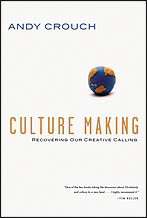
In my prior post I encouraged students who are headed toward grad school to begin their journey with a lofty end-point in mind: to grow into a person. In the Biblical sense, personhood has to do with fulfilling one’s potential as a creature who is created in the image of God. So if I stop and ask myself, Who am I? – that is, who am I at the core of my existence, the answer from scripture is that I am a representation of God, a mirror image of his being. Unfortunately, this “image” has been damaged by the Fall, yet it remains in me and is being rebuilt, gradually, through the life-long process of discipleship.
I’d like to suggest to you that grad school should be seen as a cool adventure in re-imaging. Of being reshaped back into the image of God. The Apostle Paul puts it this way: “We . . . are being transformed into His image with ever-increasing glory“ (2 Cor 3:18).
Here are two practical ways such re-imaging can take place in the academy, regardless of where you are in your matriculation (or teaching):
1. Integration. This word is used so often in a wide variety of settings these days, religious and otherwise, it may be losing a bit of its punch. Yet, the concept of integration is sound. We who are Christians should be putting our faith into our work. Think of the fingers of your left hand (faith) interlocking with the fingers on your right hand (research, course work, teaching). The two hands clasp and intertwine.
Let me offer just one illustration of how faith/study integration might play out, and trust you to translate the basic idea into your own discipline.

If I am in any field related to the sciences, I will come to my studies each day with a sense of gratitude for the privilege of studying the intricacies of the cosmos. The laws of nature are gifts of God and my scholarship represents God’s calling to harness the resources of nature for the betterment of humankind. Additionally, I will recognize a breath-taking aesthetic dimension to the creation every time I work through an equation or peer into a microscope or any instrument of discovery. The presence of aesthetics in my life expands my personhood to include the arts – in this case, the “natural” arts of the universe but also the creative arts of disease-conquering, bridge-building, crop-enhancing, animal-saving, and the like. Yes, you are an artist. The arts remind us that our basic constitution of “image of God” can never narrow itself into mere functionality or utility. We are never robots, never only technicians. We are people. And people-hood is a derivative of God-hood. To continue the metaphor, God is both scientist and artist, and if I work in the sciences, so am I. Such thinking and acting will place me on a trajectory to “become a person” in the most holistic sense. My professional life will be included in my spirituality, and this is indispensable.[1]
You may be studying banking, law, nursing, counseling, literature, history – whatever it is, this principle of faith-integration will carry you far. I am not above begging, and I beg you at this very moment to allow Jesus to enter your field of study with you. In point of fact, he arrived there long before you and has actually prepared a place for you at the table. “Come, be seated,” he bids. “Let’s you and I talk through this field of study for a few years.”
An Integrator: I remember a student named Kate Bowler at Macalester College (Minnesota) where I serve as the InterVarsity staff. She was in religious studies, a particularly difficult major for evangelical Christians due to criticism of the Bible and the western tradition. I was drawn to Kate because she was an integrator. Instead of building a wall around her faith, she absorbed the critique of the college and then found ways to offer a thoughtful reply. After graduation, she attended Yale and Duke, and was hired on to the faculty at Duke in the religion department. Integration! That was (and is) Kate’s M.O. May it be yours as well.

2. Community. I really know how to pick over-used words, don’t I? Change it to fellowship. That would be worse. Or collective, fraternity, corporate. You can see the problems with each. The point is that graduate studies should not be an individual, isolated endeavor. You and I were made for community, and let me add a modifier: Christian community. We should never, ever live our lives outside the body of Christ. Certainly not during grad school. Call me extremist or preachy on this point; I accept the appellations. Yes, we belong to more than one community, and many of these are not Christian per se. But none can substitute for the fraternal relations of fellow Christians.
And insofar as it is possible, we need to develop these relationships inside the university context. This means that I am marching through my program of study in the company of other Christians. They provide encouragement, accountability, and the plausibility of a Biblical worldview. There’s a “we-ness” to my studies rather than simply a me-ness. I realize that we-ness usually involves nonChristian colleagues, and I am not against this. On the contrary, we are in their lives and they in ours for a divine purpose, which I’ll explore in part three of this blog. But the we part of my education must include Christians as well. And if not found in my particular department, they are present elsewhere on campus, often in organized ministries, but not always. Sometimes we simply need to ask the Holy Spirit for the right connections.
Christian community moves us along the path toward full personhood because God is intrinsically relational. The members of the Trinity are unified in eternal love relations, and when the scripture says let us make man and woman in our image, there is at least a hint of essential relationality involved. In any case, God is three persons in one being. We are multiple persons in one humanity. The template is eternal, the application immediate: we simply must do life together, including life in the academy.
A Final Vision
Think of it! A skilled academic who integrates faith and learning, and does so in the company of caring Christians. That’s a powerful vision that leads to the goal of personhood – that is, of being transformed into the image of Christ.


Resources
- For an efficient summary of three major views of the doctrine of the image of God (including the views underlying this post), see Across the Spectrum by Gregory Boyd and Paul Eddy, ch 5.
- For an expanded vision of how the image of God can be expressed in the academy and culture, see Culture Making by Andy Crouch.
- For an academic treatment of faith-learning integration, including inter- and intra-disciplinary approaches, see William Hasker, “Faith-learning Integration” in Christian Scholars Review, March 1992, reprinted online here: http://www.cccu.org/professional_development/resource_library/2001/faithlearning_integration_an_overview
Rick Mattson is a national evangelist and apologist for InterVarsity, speaking at over eighty campuses the past few years. He lives in St. Paul, MN with his family. He studied at Bethel Seminary of St. Paul, MN, where he received his masters in the philosophy of religion. As part of his current duties he serves as evangelism coach for graduate students at several universities. Rick’s a committed family man and serious golfer. He is the author of three books: Faith is Like Skydiving, Faith Unexpected and Witness in the Academy.

Leave a Reply